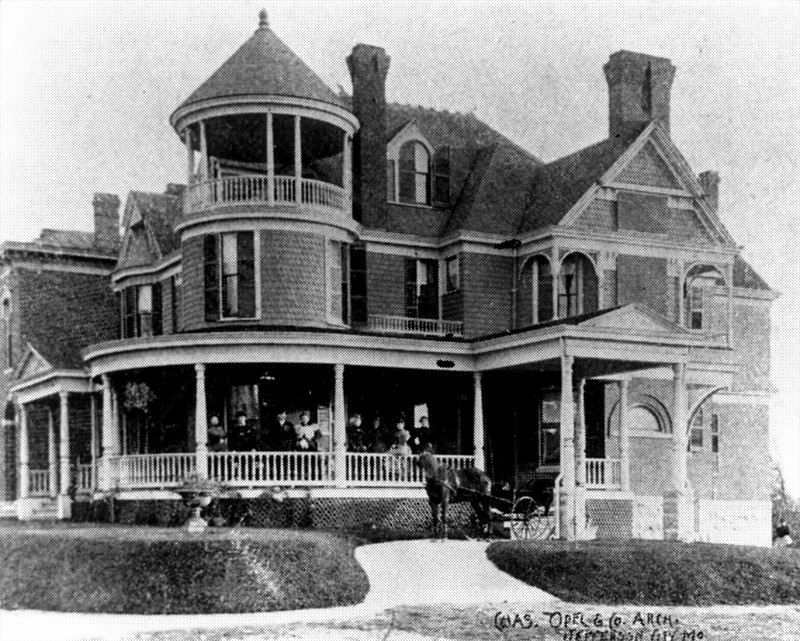Oct. 7, 1924, was the day after "New Capitol Day," when some 20,000 had celebrated, in a downpouring rain, the dedication of the newly constructed Missouri Capitol. Walking from his family home at 500 E. Main St., Gustavus Fischer needed to open his G.A. Fischer Drug Store this morning at 105 E. High St.
Having established a reputable, financially successful pharmacy in his hometown in 1887, Fischer felt confident two years later to marry the beautiful, talented Johanna Henriette (Jennie) Bruns, granddaughter of Dr. Bernard and Jette Bruns. For the first 16 years, the young family - including son Clifford and daughter Nadine - lived over the drug store, as did many other downtown business owners. However, wanting to entertain friends and join the capital's social scene with a larger home, Fischer had purchased in 1903 the 10-year old Queen Anne mansion "Ivy Terrace," former home of Gov. Lon Stephens.
Jefferson City was booming in 1924, echoing the "Epoch of Progress" pageant at "New Capitol Day." The first bridge across the Missouri was dedicated in 1896, anticipating the automobile craze into the city. Just 13 years ago in 1911, streetcars were added to the Capital City's once-dirt roads, unloading customers to High Street businesses. That same year, the all-important first city football team was organized. And the Carnegie Free Library had been dedicated in 1902, built by Miller & Opel in the 200 block of Adams Street, adjoining the notorious Hog Alley.
Some 10 years earlier, Fischer's walk down Main Street would have been difficult during the past week's downhill deluge of mud. But in 1915, Mayor Thomas declared the end to the three-block mud-infested Hog Alley by concreting the alley roadway and by enforcing again the 1872 Hog Ordinance. This ordinance vacated all alley structures, occupants and animals, even sanitizing the alley by renaming it Commercial Avenue.
G.A. Fischer - popular druggist, banker and realtor - was recognized as the "prime mover" in many progressive capital city community efforts: partnering with Sam B. Cook in organizing the Central Missouri Trust Company; opening the Jefferson City Country Club; forming the Capitol Telephone Company; developing Woodcrest Addition subdivision; and establishing Commercial Club (Chamber of Commerce) in attracting businesses to its now clean streets. He was described by contemporaries as "always a true and loyal friend to Jefferson City and ever interested in its betterment and advancement."
Continuing his stroll in 1924 along the 400 block of East Main Street, G.A. admired Daniel McIntyre's three-story yellow brick Italianate-style home. He then passed John C. Gordon's brick Italianate mansion at 429 E. Main St. with a rounded wooden porch flanked by two-story high pillars. Both historic homes were later purchased by the Buescher family and are currently abandoned.
As for their own distinguished 500 E. Main St. residence, G.A. and Jennie had attended many social events here when it was owned by former Gov. Lon V. Stephens. They were awe-struck by the stately mansion bearing the romantic, almost aristocratic title, "Ivy Terrace." After razing Dr. William Bolton's Civil War-era mansion on the same lot, local architect Charles Opel designed "Ivy Terrace" in 1893 for Stephens when he was state treasurer.
The Stephens enjoyed their uniquely designed home for only three years, a time filled with lavish parties and masquerade balls on the third floor. In 1896, Stephens was elected Missouri's governor for one term. Before moving to the Governor's Mansion, however, his wife, Maggie, refused to move her family out of her beloved Ivy Terrace into the decrepit mansion until the structure was repaired. After the governor's term, the family briefly returned to Ivy Terrace until moving to St. Louis, where Stephens died in 1923.
Fischer heirs sold Ivy Terrace to Mary E. Wood in 1948 after G.A.'s death five years earlier. Wood operated the Mariwood Beauty Culture School in the mansion for 18 years, graduating some 900 students. Wood sold it to Thomas and Dee Whitecotton in 1966 after their assurance of restoration to her beloved historical home.
Tom and Dee Whitecotton's dedication to preservation breathed new life into Ivy Terrace. The 2 -story exuberant Queen Anne had retained the original eight hand-carved fireplaces featuring imported Italian tiles, five sets of sliding paneled doors on the first floor, art-glass windows, and the entry's grand hand-carved oak staircase.
The most significant exterior characteristics are its fairy-tale open-air turret providing a semi-circular sitting area in the first-floor parlor and second-floor master bedroom; extensive wrap-around porch with stately entrances; high, steeply pitched roofline; fish-scale shingles; and a covered porte-cochere.
G.A. Fischer, described in his 1943 obituary as "Banker, Merchant, and Town Builder," enjoyed Ivy Terrace in the historic Capitol Avenue neighborhood with his family for some 40 years. Unfortunately, another 40 years placed the once elegant home on the city's endangered properties list in substantial need of repairs and rescue. Such a rescue would define a "New Capitol Day" for this historic city landmark.
Carolyn Bening, a former assistant editor of Historic City of Jefferson's Yesterday & Today newsletter, is a local historian, retired high school and university teacher, and genealogist.

